Potato (Solanum tuberosum) is the world’s third most important food crop after wheat and cereal and is a staple food for over 1.3 billion people. The overall value of the potato crop to the global economy largely comes from the processing of potatoes, with the industry in the USA alone valued at over $100B employing over 700,000 people1. The global significance of potatoes heightens the importance of combating the potato’s nemesis, late blight (Phytophthora infestans). Late blight, a quickly spreading disease, is caused by the oomycete pathogen and can have a devastating impact on the potato industry.
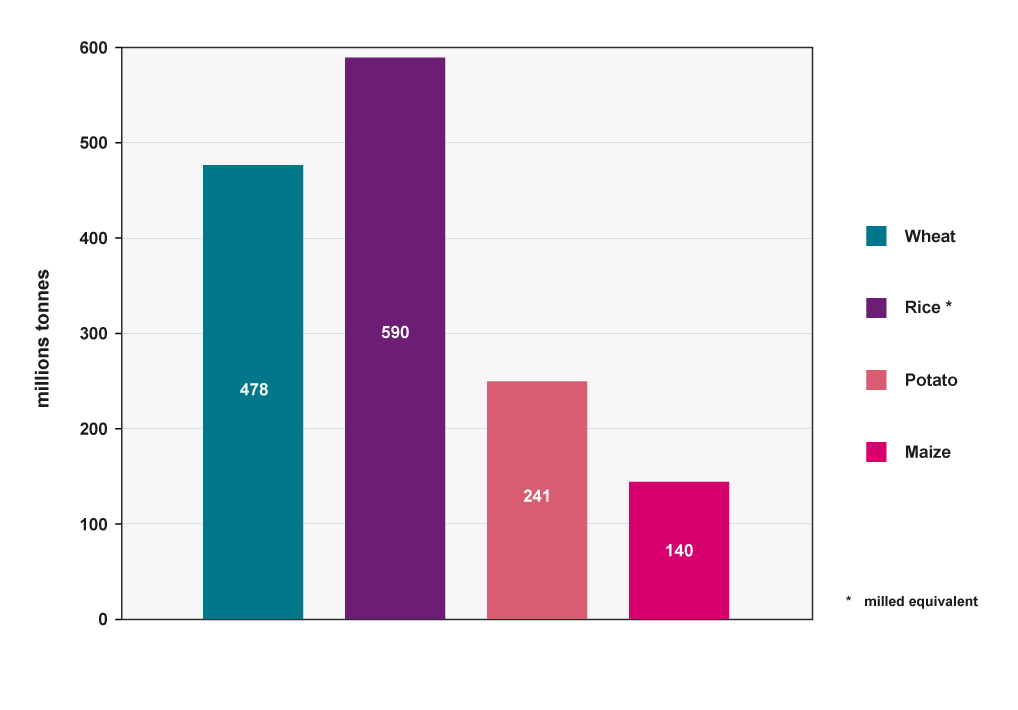 |
| Figure 1: FAOSTAT, New Food Balances, February 2020 |
In developed countries, fungicide spray programs for the control of late blight account for the highest proportion of fungicide use for disease control worldwide. When considering crop losses in addition to the cost of control measures to minimise disease impact, the disease is estimated to cost US$6.7 billion worldwide annually2.
The Phytophthora infestans genome is about 840 Mb in size consisting of blocks with conserved gene sequences with relatively low numbers of repeats, separated by sparse regions with alternating gene sequences, having low density but a large number of repeats3. The P. infestans genome is also extremely rich in transposons, occupying about one-third of the total genome together with the repeat and sparse regions. All these factors stimulate mutational variability in P. infestans3.
P. infestans also generate oospores, which are capable of remaining viable in soil and plant debris for several years, giving rise to the opportunity for reinfection over a prolonged period.
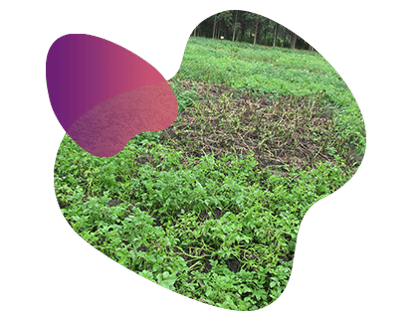 |
| Image credit: Moctar Kante, CIP. Late blight susceptible clone. |
The International Potato Centre (CIP) in Peru, a CGIAR research centre with a focus on potato, sweet potato and Andean roots and tubers. CIP delivers innovative science-based solutions to enhance access to affordable nutritious food, foster inclusive sustainable business and employment growth. CIP also drives the climate resilience of root and tuber agri-food systems. Headquartered in Lima, Peru, CIP has a research presence in more than 20 countries in Africa, Asia and Latin America.
CIP has made significant advances in the use of advanced biotechnology and molecular methods to transfer late blight-free resistance from wild relative crops to cultivated potatoes. These varieties were then thoroughly evaluated at the ILRI-BecA (Biosciences eastern and central Africa) Hub in Kenya and the National Agricultural Research Organization in Uganda and are currently resistant to late blight. These blight resistant potatoes are grown in several countries. Three late blight resistant varieties were released in 2023 in Peru.4
These new potato cultivars have been bred using resistance genes against P. infestans (Rpi genes) that originate from wild relatives of potato, and imported material, but such programmes are complex and long. New approaches focus on identifying key Rpi genes through GWAS studies followed by genetic engineering to construct what are known as "gene pyramids" or combinations of multiple Rpi genes. Single gene resistance strategies can often be overcome by rapidly evolving pathogens.
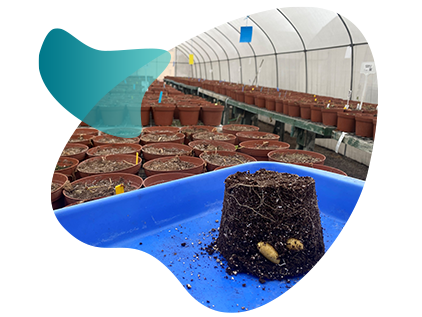 |
| Image credit: Moctar Kante, CIP. CIP observational study. |
The projects objectives were:
- Perform GWAS for late blight resistance.
- Evaluation of haplotype inheritance in several pre-breeding families.
- Provide information on SNPs that are present in the flanking sequence of each target marker.
For this project CIP used Flex-Seq targeted genotyping by sequencing as part of the creation of custom panels for potato breeding programs. They selected Flex-Seq as its two-probe hybridisation process allows for the detection of SNPs of interest at in flanking regions.
Flex-Seq targets individual regions using the two Flex-Seq probes, often focusing on a single SNP. Probes can be designed to flexibly bind on either side of the SNP, leading to greater ability to recover desired targets. Once both probes bind, the complementary sequence is synthesised between the probes and the target region is amplified from the genomic DNA. The genomic DNA and non-specific binding products are removed. The proprietary Flex-Seq probes enable high levels of target multiplexing in a single reaction.
Tuber samples were from pre-breeding material from CIP in Peru. The samples were selected based on diversity between families and their late blight resistance rating.
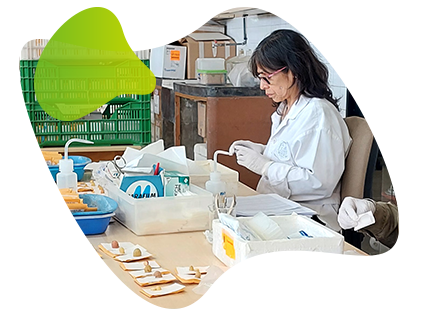 |
| Image credit: Moctar Kante, CIP. Sample preparation at CIP. |
Data processing is still ongoing but initial results look positive and will provide information on SNPs that are present in the flanking sequence of each target marker. Read depth information and allele read counts will further be used to compute the allele dosage calling and compare it with RG-provided dosage.
Once the data processing is complete the plan is to genotype elite varieties/parents on the high density Flex-Seq panel targeting 20K loci.
We asked lead CIP scientist Moctar Kante what benefits genotyping can deliver for breeders.
"Cost efficiency is the key benefit; the possibility to select for a trait or a group of traits in early stages of the breeding cycle, and the possibility to select for parents in early stages of the breeding cycle can increase short-term genetic gain. Accurate phenotypic evaluation for key traits can be expensive, and disease evaluation when the disease does not naturally occur in field plots can reveal resource inefficiencies. So, using molecular markers when managing large number of clones for disease characterization is a useful option. For other traits, depending on the breeding focus, the use of markers can happen in early stages or late stages, or the fixed effect of some markers can be accounted for in prediction models." M. Kante Associate Scientist-Potato Breeder, CIP
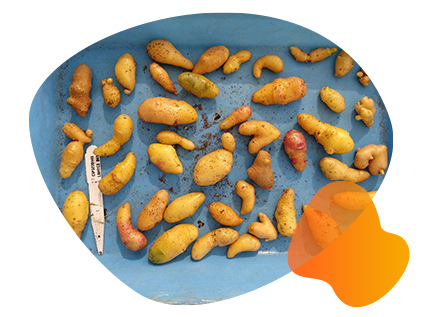 |
| Image credit: Moctar Kante, CIP. The negative impact of heat stress. |
Upon receiving the Flex-Seq 20K loci results CIP were able to request the discovery mode data which delivered around 200K of SNPs. They found that the obtained reads were on average 4 times longer than GBS’s typical 50 bases with Flex-Seq giving 200 nucleotides-long reads. Moctar is currently analysing the data.
In the future they are hoping to look at disease resistance traits for Potato virus Y (PVY) and bacterial wilt - the second and third most significant potato diseases. Innovative research is needed to understand bacterial wilt pathogenicity and virulence before durable resistance can be developed to that disease. They will also be investigating traits for higher yield, dry matter content, biotic stress tolerance including heat stress, good quality tuber and hybrid breeding.
The Flex-Seq genotyping platform for potato comes ready made with markers for Potato virus Y resistance.
To
find out more about Flex-Seq visit our information pages or get in touch with someone from our team of experienced scientists to discuss your genotyping needs.
CIP genotyping was supported by the Crop Wild Relative project and USAID funds. Samples were kindly provided by Mariela Aponte, responsible for pre-breeding activities in Lima.
Related content
References
- National Potato Council, Annual Potato Yearbook 2023, (PDF) p38.
- Caruana, B.M., de Boer, R.F., Rodoni, B. et al. Genetic epidemiology of late blight in Australia using ancient DNA. Australasian Plant Pathol. 52, 487–499 (2023). https://doi.org/10.1007/s13313-023-00936-6
- Ivanov AA, Ukladov EO, Golubeva TS. Phytophthora infestans: An Overview of Methods and Attempts to Combat Late Blight. J Fungi (Basel). 2021 Dec 13;7(12):1071. https://doi.org/10.3390%2Fjof7121071
- Gastelo M., Pérez W., Eyzaguirre R. et al. CIP-PODEROSA CROCANTE, CIP-PODEROSA POLLERA, and CIP-PODEROSA WATIA: New Potato Varieties for Family Farming with Resistance to Late Blight and High Quality for the Frying Industry. Am. J. Potato Research 100, pages 288–303 (2023). https://link.springer.com/article/10.1007/s12230-023-09917-3







